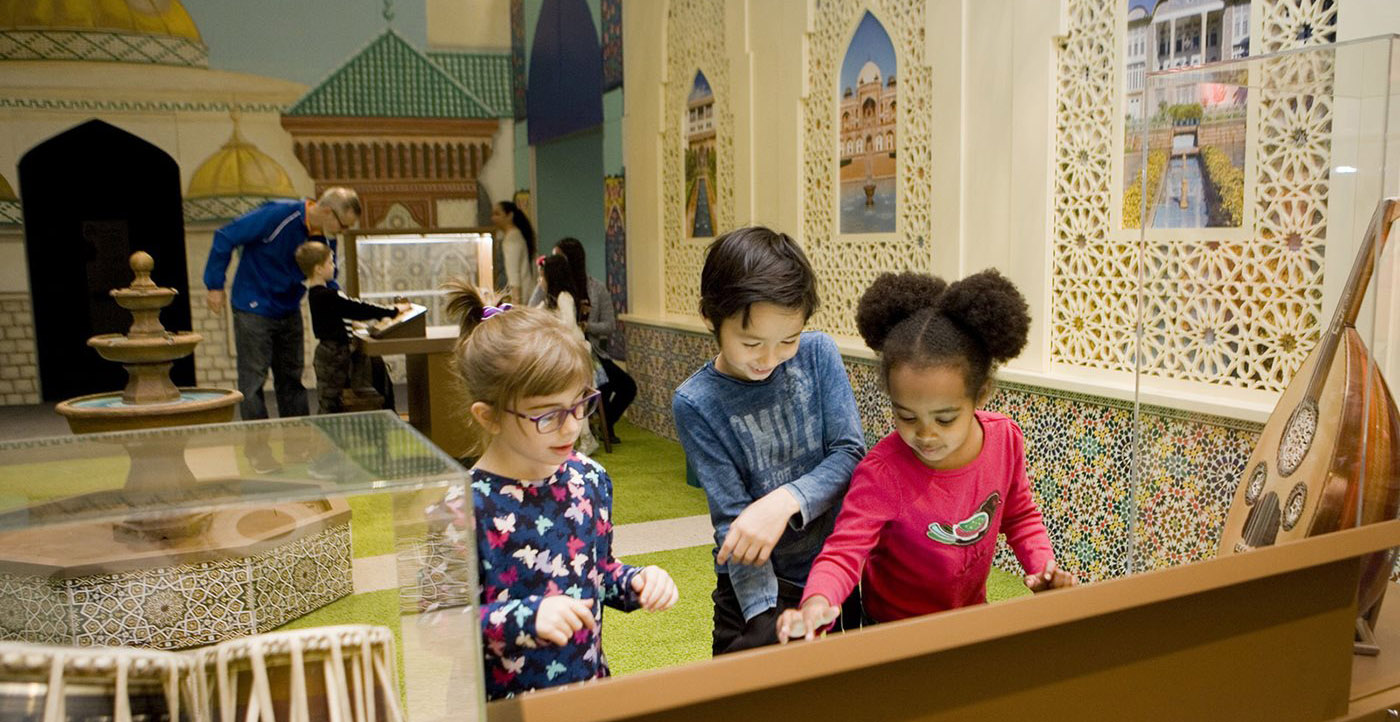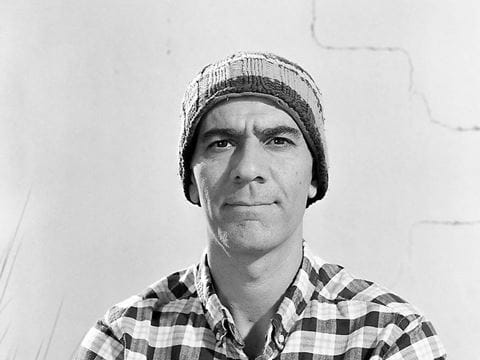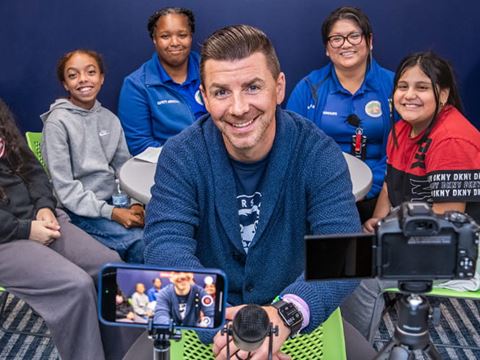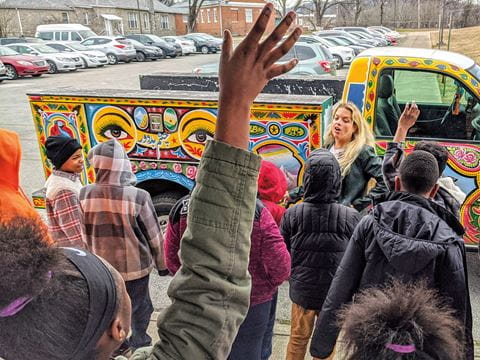
Evaluating Art as Visual Representations
Subject:
Art
Media Studies
Region:
North Africa
"Art brings people together," writes Lee Lawrence in the first paragraph of "The Art Bridge," just before asking whether it is true or not.
For students: We hope this guide sharpens your reading skills and deepens your understanding.
For teachers: We encourage reproduction and adaptation of these ideas, freely and without further permission from AramcoWorld, by teachers at any level.
Common Core Standards met in this lesson: RL/RI.1, RL/RI.2, W1 (see details below).
—The Editors
Do you have comments? I'd be pleased to hear from you at [email protected].
—Julie Weiss
For teachers: We encourage reproduction and adaptation of these ideas, freely and without further permission from AramcoWorld, by teachers at any level.
Common Core Standards met in this lesson: RL/RI.1, RL/RI.2, W1 (see details below).
—The Editors
Do you have comments? I'd be pleased to hear from you at [email protected].
—Julie Weiss
The Art Bridge
"Art brings people together," writes Lee Lawrence in the first paragraph of "The Art Bridge," just before asking whether it is true or not. The rest of the article presents four case studies of art projects that were funded as Building Bridges by New York-based Doris Duke Charitable Foundation for the express purpose of bringing people together. Although, as Lawrence asserts, it's difficult—maybe even impossible— to measure how well Building Bridges fulfilled its aim, it's still worth trying to figure out if it did. In the activities that follow, you will use the content of "The Art Bridge" to answer Lee Lawrence's initial question, "Does art bring people together," by:
- Identifying different ways that art may bring people together.
- Providing examples from the article of these different bridging methods.
- Making a visual representation of art as a bridge.
The Metaphor of the Art Bridge: Starting and Ending Points
Begin by thinking about bridges. Go online and find some pictures of famous bridges, such as the Golden Gate Bridge, the Tower [of London] Bridge, the Ponte Vecchio, the Bosporus Bridge and so on. Choose one bridge and find out the following: What two places does the bridge connect? What does it cross in order to connect them? Share with others what you've learned about your specific bridge.
Now think about bridges as a metaphor. Remember that a metaphor is a figure of speech in that something represents or symbolizes something else. To talk about art as a bridge is an example of a metaphor. The Building Bridges program doesn't build actual bridges. Instead, building bridges is a metaphor. Based on what you found out about actual bridges, what do you think an art bridge might be a symbol for?
For the rest of this activity, make a visual representation of a bridge. You can make it on a wall or on the floor, using pieces of paper as symbols of the pieces of an actual bridge. Start by asking about the Art Bridge the same two questions you asked about the famous bridge you looked at before. First, what two places does the Art Bridge connect? To answer the question, read the article, "The Art Bridge." As you read, highlight or make a list of how different people explain where they assume people are starting—the origination point of the bridge. For example, people start with their own experience, such as their own music and their own kind of clothing; people also start with stereotypes about others. Share your starting points with others in the class; then have another student or two find a way to display the starting points as one end of your Art Bridge. Go through the same process with the end point—the place artists hope people will get to. For example, people learn about the experiences of others; people learn about unique, complicated people, and so on. Develop a way to display the far end of the bridge.
With both ends of the bridge in place, consider the second question: What does the bridge that connects both places need to cross? The famous bridge you looked at crossed a body of water. What does the Art Bridge cross instead of actual water? Identify the space between the start and the end of the bridge. Draw and label it. You might, for example, draw it as a body of water, but label it with what the water stands for.
Begin by thinking about bridges. Go online and find some pictures of famous bridges, such as the Golden Gate Bridge, the Tower [of London] Bridge, the Ponte Vecchio, the Bosporus Bridge and so on. Choose one bridge and find out the following: What two places does the bridge connect? What does it cross in order to connect them? Share with others what you've learned about your specific bridge.
Now think about bridges as a metaphor. Remember that a metaphor is a figure of speech in that something represents or symbolizes something else. To talk about art as a bridge is an example of a metaphor. The Building Bridges program doesn't build actual bridges. Instead, building bridges is a metaphor. Based on what you found out about actual bridges, what do you think an art bridge might be a symbol for?
For the rest of this activity, make a visual representation of a bridge. You can make it on a wall or on the floor, using pieces of paper as symbols of the pieces of an actual bridge. Start by asking about the Art Bridge the same two questions you asked about the famous bridge you looked at before. First, what two places does the Art Bridge connect? To answer the question, read the article, "The Art Bridge." As you read, highlight or make a list of how different people explain where they assume people are starting—the origination point of the bridge. For example, people start with their own experience, such as their own music and their own kind of clothing; people also start with stereotypes about others. Share your starting points with others in the class; then have another student or two find a way to display the starting points as one end of your Art Bridge. Go through the same process with the end point—the place artists hope people will get to. For example, people learn about the experiences of others; people learn about unique, complicated people, and so on. Develop a way to display the far end of the bridge.
With both ends of the bridge in place, consider the second question: What does the bridge that connects both places need to cross? The famous bridge you looked at crossed a body of water. What does the Art Bridge cross instead of actual water? Identify the space between the start and the end of the bridge. Draw and label it. You might, for example, draw it as a body of water, but label it with what the water stands for.
The Art Bridge: What Is It Made of?
Now you've gotten a clear sense of what amps and photos can tell you about Khartoum. But maps and photos can only go so far. Alone, can they really help you know the heart of the place? How can a magazine article give a reader a real sense of what Khartoum is like?
Yes, the bridge is made of art; hence the name. But let's look more closely. How does art bring people together? The answers to that question form the pieces that make up your bridge. You can find the answers in different parts of the article. For example, some of the offset quotes (short sidebars) provide information from scholars. One of these is an explanation of "joint attention," which could be one of the pieces of the bridge. Your might write the following: "Joint attention—looking at and appreciating art with another person can make you feel more positive about that person." See if you can come up with at least five steps for your art bridge. For each step, provide at least one example from the article that shows that step in action.
Now you've gotten a clear sense of what amps and photos can tell you about Khartoum. But maps and photos can only go so far. Alone, can they really help you know the heart of the place? How can a magazine article give a reader a real sense of what Khartoum is like?
Yes, the bridge is made of art; hence the name. But let's look more closely. How does art bring people together? The answers to that question form the pieces that make up your bridge. You can find the answers in different parts of the article. For example, some of the offset quotes (short sidebars) provide information from scholars. One of these is an explanation of "joint attention," which could be one of the pieces of the bridge. Your might write the following: "Joint attention—looking at and appreciating art with another person can make you feel more positive about that person." See if you can come up with at least five steps for your art bridge. For each step, provide at least one example from the article that shows that step in action.
Evaluating the Art Bridge: Does Art Bring People Together?
Look at someone else's art bridge. Think about where people start about the steps they take as they walk across the art bridge. Do those steps lead them to the other side? Do they bring them together? Talk this over with a partner or small group. Then, choose one of the following as a culminating activity:
Look at someone else's art bridge. Think about where people start about the steps they take as they walk across the art bridge. Do those steps lead them to the other side? Do they bring them together? Talk this over with a partner or small group. Then, choose one of the following as a culminating activity:
- Write an essay with the thesis statement: Art brings (or does not bring) people together. Provide supporting evidence to convince a reader of your point of view.
- Create a work of art that shows either how art brings people together or how it fails to do so.
Common Core Standards met in this lesson:
RL/RI.1 Read closely to determine what the text says explicitly and to make logical inferences from it; cite specific textual evidence when writing or speaking to support conclusions drawn from the text.
RL/RI.2 Determine central ideas or themes of a text and analyze their development; summarize the key supporting details and ideas.
W1 Write arguments to support claims in an analysis of substantive topics or texts, using valid reasoning and relevant and sufficient evidence.
Other lessons

Spaces for All
For the Teacher's Desk
Built environments can foster community within cities and neighborhoods and change how we view the world.
Learn the Art of Collaboration via the Art of Tiles
For the Teacher's Desk
With Portuguese tiles as teaching tools, discover how teamwork builds something lasting.
How Art Connects
For the Teacher's Desk
Art links everything—cultures, history, even math. Want to hook students? Try teaching through the art that surrounds us with these stories.